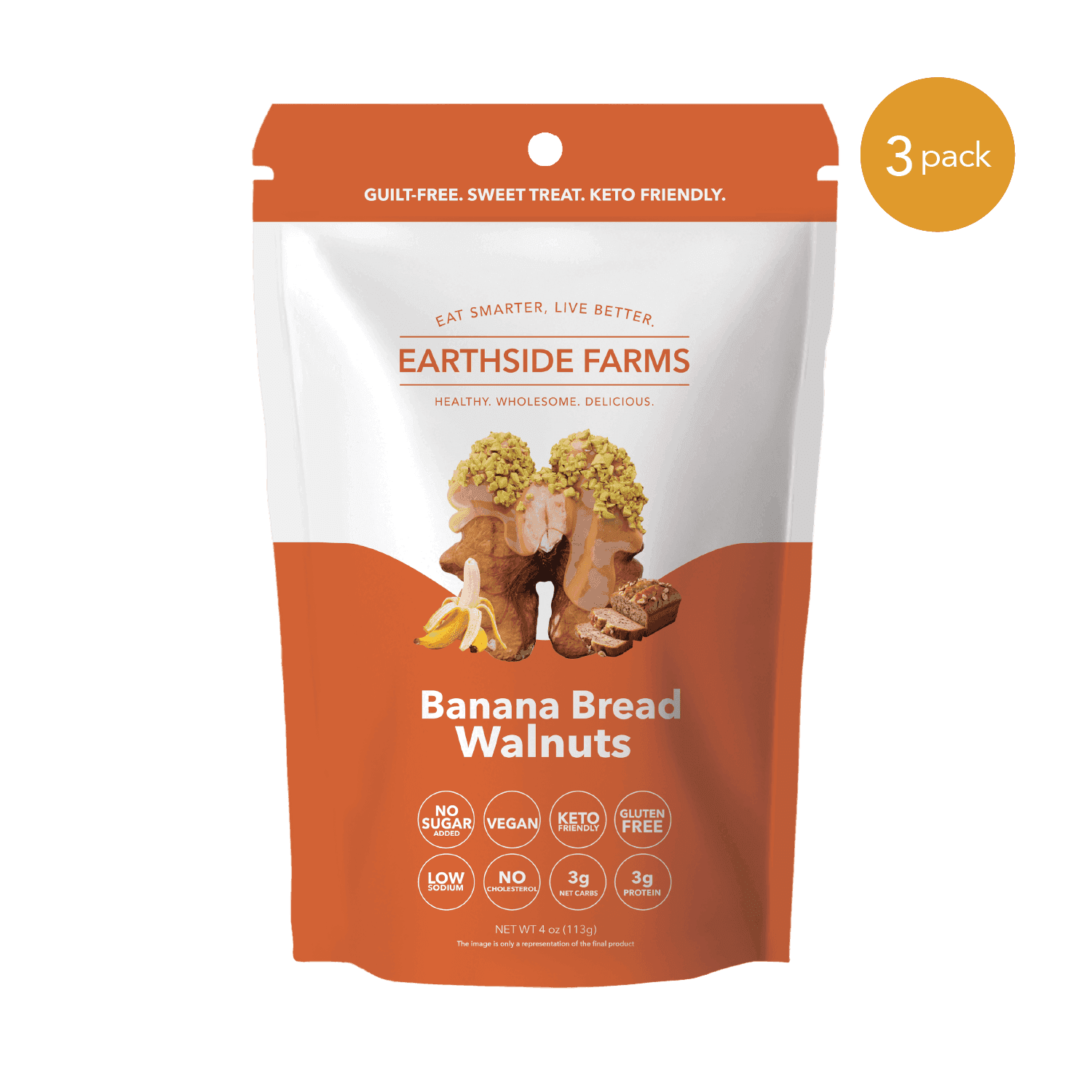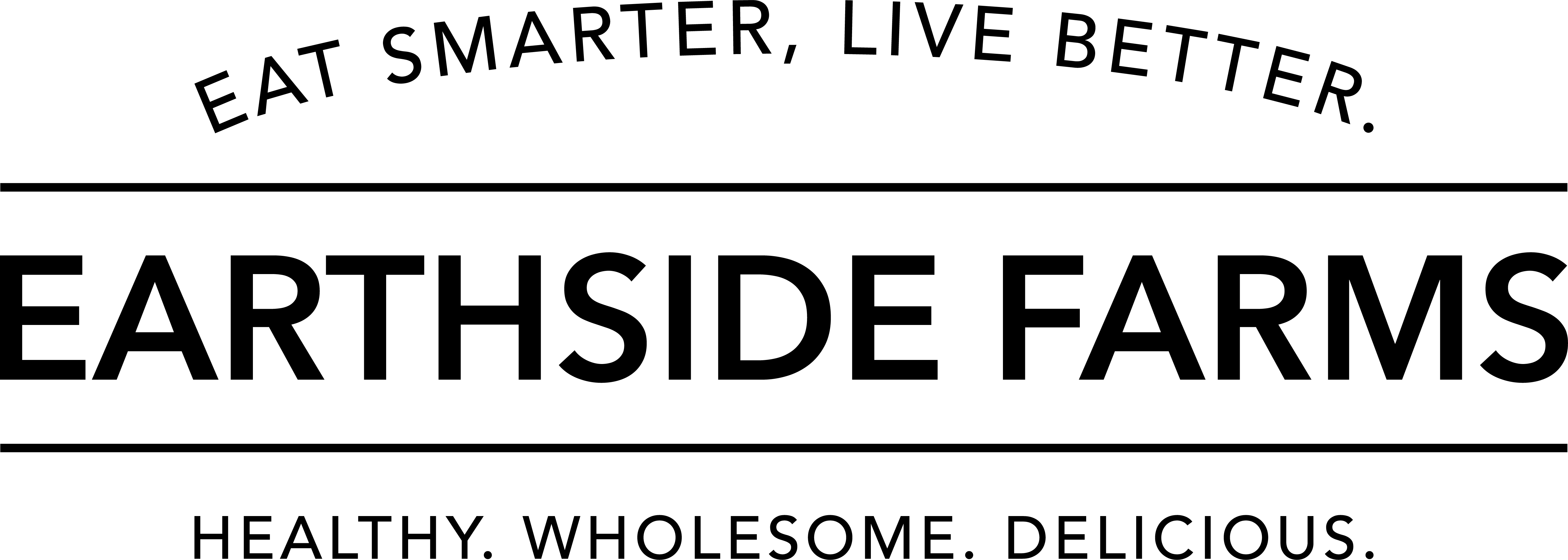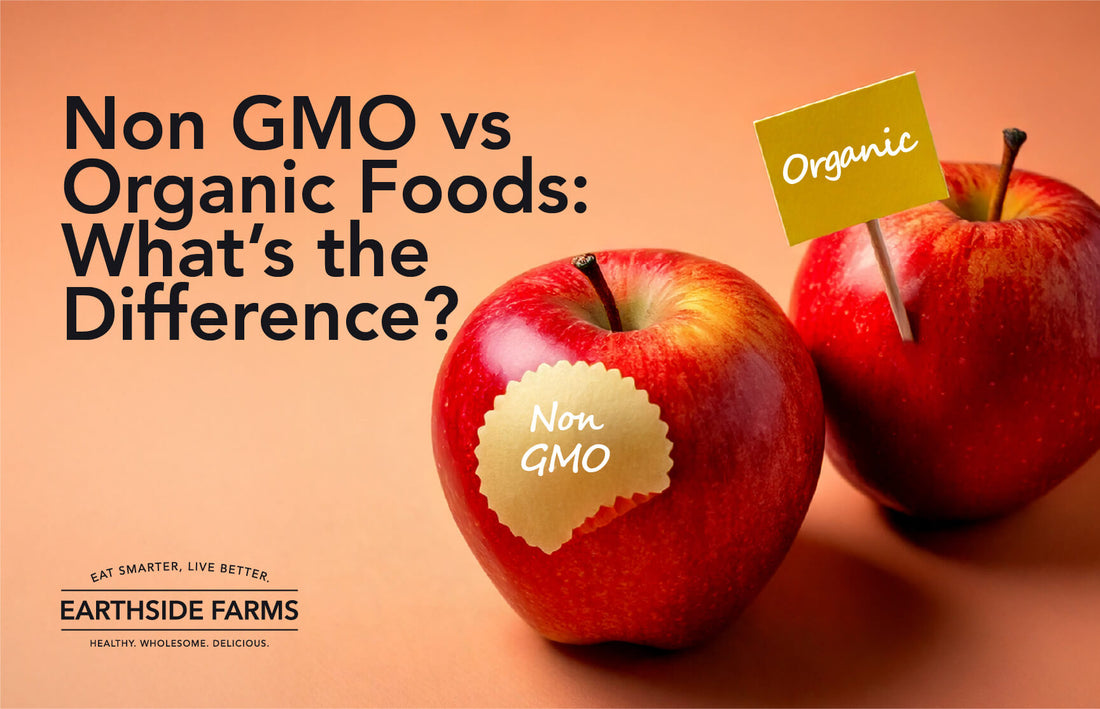The next time you're at the grocery store, you'll likely face a common dilemma:
Which one should you choose, non-GMO or organic?
The labels seem similar, but the differences go deeper than you might think.
Is it better to eat non-GMO or organic? Are they truly the same thing, or does one offer more benefits than the other?
Let's explore what makes organic food different from non-GMO and why this knowledge could be a game-changer the next time you fill your cart.
What Is Non-GMO?
Non-GMO stands for non-genetically modified organism.
GMOs are created when scientists alter the DNA of crops to introduce traits like pest resistance or higher yields.
It's done in a lab, not a greenhouse.
A non-GMO food, therefore, does not contain any genetically engineered ingredients.
But it doesn't necessarily mean pesticide-free, organic, or grown using natural methods.
How Is It Verified?
Most recognized is the non-GMO project verified seal.
This goes beyond just a marketing claim as it involves a third-party certification process involving:
-
Ingredient testing for high-risk crops.
-
Ongoing audits and documentation reviews.
-
Supply chain checks to prevent contamination.
It's one of the most trusted symbols for avoiding GMOs, especially in a market where labeling is often inconsistent.
What Foods Are Usually Genetically Modified?
Not every crop is genetically engineered.
There are just a handful of common offenders—yet they show up everywhere in processed foods:
-
Soy
-
Corn
-
Canola
-
Sugar beets
-
Cottonseed oil
If you're eating packaged snacks or dressings, there's a good chance one of these ingredients is hiding inside.
Why Should You Avoid GMOs?
There's no conclusive evidence that GMOs are unsafe, but many consumers still avoid GMOS. They are cautious for several reasons, such as:
-
A desire for transparency and natural growing practices
-
Concerns over the long-term health effects of consuming altered DNA
-
Pesticide resistance in GMO crops, which can lead to heavier chemical use
That's why the non-GMO movement gained momentum.
It's not because all GMOs are proven harmful, but because many people want food that's closer to its natural roots.
What Does It Mean to Be Organic?
Many people throw away "organic" as if it were some feel-good buzzword.
But it's way beyond that.
It's a federally regulated standard with strict rules for how food is grown, processed, and handled.
And yes, organic food is always non-GMO by definition, but that's just the beginning.
Sure, organic farming bans genetically modified organisms, but it goes further.
Organic rules cover every aspect of farming and food production, from soil to store shelves.
It's a system that:
-
Promotes biodiversity.
-
Protects natural ecosystems.
-
Supports humane animal treatment.
So you can consider organic a full-circle commitment beyond just avoiding what's artificial.
It's really embracing what's natural.
What It Takes to Be USDA Organic
Getting certified isn't easy—and that's the point. Here's what farmers and producers must do to earn the USDA Organic seal:
-
Zero synthetic pesticides or fertilizers
-
No GMOs, ionizing radiation, or sewage sludge
-
Annual inspections by USDA-accredited certifiers
-
Outdoor access and humane treatment for livestock
-
A three-year transition period before the land qualifies
-
Organic-only feed for animals, with no antibiotics or hormones
Also, the label doesn't stick forever.
It's renewed yearly through audits, documentation, and site visits.
How Does Organic Farming Work?
Organic farming doesn't end with making a list of substances and banning them.
It's embraced as a mindset reflected in the organic farming process.
Farmers use natural strategies to build soil health, control pests, and grow resilient crops.
Instead of synthetic fertilizers, they use compost, manure, and cover crops to return nutrients to the earth.
Crop rotation helps reduce disease and discourages pests without the need for harsh chemicals.
Only methods approved by the Organic Materials Review Institute (OMRI), such as insect traps or natural sprays, are allowed for pest control.
Even livestock is treated differently.
Animals are given outdoor access and raised on certified organic feed without antibiotics or growth hormones.
These practices are carefully chosen to:
-
Protect ecosystems
-
Improve soil structure
-
Keep our food chain as close to nature as possible.
Why People Choose Organic
So, is organic really worth it? For many shoppers, the answer is yes. Here's why:
-
Fewer synthetic residues in your food
-
Support for animal welfare and small-scale farms
-
Better soil & water health from sustainable farming
-
Trust in how your food was made, from seed to shelf
Does it make a difference?
Well, what's the cost of not knowing what's in your food?
There's your answer.
Non-GMO vs Organic: Key Differences
It's easy to assume that non-GMO and organic mean the same thing.
But these two labels tell very different stories about how your food is grown, processed, and verified. Here's how they really stack up.
|
Category |
Non-GMO |
Organic |
|
Core Focus |
Avoids genetically modified organisms (GMOs) |
Avoids GMOs and synthetic chemicals; promotes holistic farming |
|
Certification Body |
Non-GMO Project (independent nonprofit) |
USDA National Organic Program |
|
Verification Timeline |
3–6 months |
3 years (minimum) for land transition + annual inspections |
|
Pesticide Use |
Allowed (even synthetic ones like glyphosate) |
Prohibited—only natural or OMRI-approved substances allowed |
|
Fertilizers |
No restriction |
No synthetic fertilizers |
|
Animal Feed |
Must be non-GMO, but not necessarily organic |
Must be organic and free of antibiotics/hormones |
|
Animal Welfare |
Not addressed |
Required—access to pasture, humane treatment |
|
Environmental Standards |
Not required |
Built-in—soil health, biodiversity, sustainability |
|
GMO Testing |
Required for high-risk crops |
Not required—relies on exclusion methods and documentation |
|
Label Meaning |
Focused on gene modification only |
Indicates full compliance with strict health and environmental standards |
Can Organic Be Non-GMO?
The short answer is that organic is always non-GMO.
However, there is a long answer that is a little complicated, but we'll explain it.
Let's clear up the confusion for good.
Under USDA organic regulations, GMOs are strictly prohibited at every stage of production.
That means:
-
No animal feed containing GMOs
-
No genetically engineered seeds or crops
-
No enzymes, additives, or processing aids derived from GMOs
So when you see the USDA Organic seal, you can trust the product has been grown and processed without any GMOs.
But organic farmers can still end up with GMO contamination, even when they've done everything right.
How?
-
Bees can cross-pollinate between fields.
-
Wind can carry GMO pollen from neighboring farms.
-
Even shared harvesting or transport equipment can leave traces behind.
USDA rules account for this.
If a farmer follows all the organic requirements and takes documented steps to prevent contamination, the product can still be labeled organic, even if trace GMO material is found.
That said, farmers are encouraged to plant buffer zones, change planting schedules, and separate storage spaces to minimize the risk.
So, yes, organic food is intended to be non-GMO, but nature sometimes complicates that mission.
Is Non-GMO Always Organic?
Now let's flip it.
Just because a product is non-GMO doesn't mean it's organic.
A non-GMO verified product avoids genetically engineered ingredients, but that's where its responsibility ends. It can still be:
-
Processed with artificial additives or preservatives
-
Grown with synthetic pesticides or chemical fertilizers
-
Produced on farms that use conventional, chemical-heavy practices
-
Sourced from animals raised without access to pasture or given antibiotics
That's because the Non-GMO label is a single-issue certification.
It tells you only that GMOs were avoided. It doesn't tell you how the food was grown, handled, or processed.
In contrast, organic certification covers a whole ecosystem of standards, including soil health, sustainability, animal welfare, and yes, the absence of GMOs.
Can a GMO Ever Be Organic?
This one's easy: No.
USDA organic rules explicitly list GMOs as an excluded method.
That means anything made using genetic engineering—whether traditional GMO methods or newer techniques like CRISPR gene editing—can not be certified organic.
Ever.
Even if the modified gene was added to help the crop grow faster or resist drought, it's still off-limits.
And if someone tries to sneak a genetically modified ingredient into an organic product?
That violation has serious consequences, including losing certification or being removed from the organic marketplace.
Why Both Labels Exist?
Simple. Because it offers double assurance.
USDA Organic confirms the product meets a full range of farming and processing standards, including no GMOs.
Non-GMO Project Verified adds extra ingredient-level testing, especially useful for high-risk crops like corn, soy, and canola.
Seeing both labels means the brand went the extra mile to prove its integrity, both in its farming practices and ingredient sourcing.
Are Non-GMO Products Healthier?
Not always—and not necessarily.
The non-GMO project verified label tells you the product contains no genetically modified organisms.
That's it.
It does not mean:
-
The product is organic.
-
The food is more nutritious.
-
The ingredients are pesticide-free.
-
It's free from artificial preservatives or additives.
Non-GMO foods can be ultra-processed, loaded with sugar, or grown with synthetic pesticides.
The label simply ensures gene editing wasn't part of the recipe.
So, if you grab a Non-GMO granola bar, it could still contain:
-
Artificial flavors and stabilizers
-
Non-organic oats sprayed with glyphosate
-
Cane sugar from conventionally farmed sources
Non-GMO = no engineered DNA, not no chemicals.
So, Why Do People Associate It With Health?
Because GMOs are controversial.
Many consumers worry that genetically modified crops might cause:
-
Allergies are not seen in natural food.
-
Digestive issues or gut microbiome disruption.
-
Long-term health effects that haven't been fully studied.
While scientific consensus generally considers GMO foods safe to eat, skepticism remains.
That's primarily due to how GMO crops are linked with heavy pesticide use and monoculture farming.
That's why some people avoid GMOs.
Not just for what they are, but what they represent.
Is Organic a Healthier Choice Than Non-GMO?
In most cases, yes. Organic foods are grown:
-
Without GMOs
-
Without synthetic pesticides/herbicides
-
Without artificial additives or preservatives
Due to soil health and farming practices, they're also less likely to carry chemical residues and often have higher antioxidant content.
So while non-GMO is a step in the right direction, organic generally offers a wider health benefit because of how the entire product is made, not just what it excludes.
It's Not Just About the Label. It's About the Whole Package.
Want a Non-GMO product that's actually good for you?
Check beyond the butterfly logo. Look at the ingredient list. Ask:
-
Is it minimally processed?
-
Are the ingredients organic?
-
Is there added sugar or sodium?
-
Are there artificial colors or stabilizers?
Because truthfully, a non-GMO candy bar isn't automatically healthier than an organic apple.
Non-GMO Project vs Organic: Which One to Choose?
The answer depends on what matters most to you.
Organic isn't just about avoiding certain ingredients but about how the entire system works.
If you care about clean food, clean farming, and long-term sustainability, organic gives you the whole picture.
|
Label |
Primary Focus |
Covers Farming Practices? |
Covers Animal Welfare? |
Includes Annual Inspections? |
|
Non-GMO Project Verified |
Avoids genetically modified ingredients |
No |
No |
Yes |
|
USDA Organic |
Avoids GMOs *and* chemicals and more |
Yes |
Yes |
Yes |
So, you can think of non-GMO as a starting point and organic as a standard you can use to grow.
Choose Non-GMO if:
You're focused strictly on avoiding genetically engineered ingredients.
Especially useful for buying packaged foods with hidden GMOs.
Choose Organic if:
You want a full commitment to food safety, sustainability, and animal welfare.
Especially important for fresh produce, dairy, grains, and meats.
Choose Both if:
You want the best of both worlds.
Many high-integrity brands carry both seals to demonstrate transparency and dedication.
The Right Choice for You
You came here looking for clarity—and now you've got it.
So, where can you find snacks that live up to both standards?
Check out Earthside Farms as your go-to for organic and non-GMO certified snacks that are as clean as they are craveable.
Frequently Asked Questions
Here are some FAQs related to this topic:
Is it better to eat non-GMO or organic?
Organic generally offers broader benefits.
It includes non-GMO standards and goes further, banning synthetic pesticides, improving soil health, and enforcing animal welfare.
Non-GMO is a good start, but organic gives you the full package.
Can something be non-GMO but not organic?
Yes. A non-GMO product only avoids genetic engineering.
It might still be grown with synthetic chemicals, processed with artificial additives, or from conventional farms.
Organic covers more ground.
Why are GMOs not healthy?
While research is ongoing, many consumers are concerned about the long-term effects of genetically modified foods.
Especially due to pesticide resistance and lack of labeling transparency.
Some prefer to avoid GMOs as a precaution.
Why is GMO banned in Europe?
European countries follow the precautionary principle—new technologies must be safe before being widely adopted.
Due to environmental concerns, limited long-term studies, and public skepticism, GMOs face heavy restrictions or outright bans in much of Europe.


